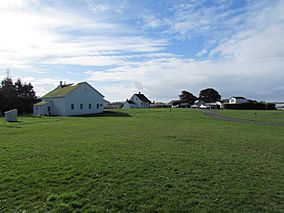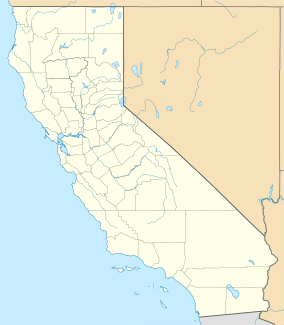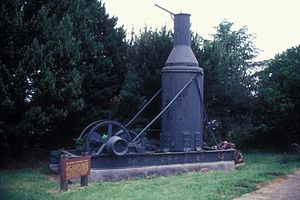Fort Humboldt State Historic Park facts for kids
Quick facts for kids Fort Humboldt State Historic Park |
|
|---|---|

View of Fort Humboldt
|
|
| Location | Humboldt County, California, United States |
| Nearest city | Eureka, California |
| Area | 18 acres (7.3 ha) |
| Established | 1955 |
| Governing body | California Department of Parks and Recreation |
| Reference #: | 154 |
Fort Humboldt State Historic Park is a special place in Eureka, California, where you can learn about an old U.S. Army fort. This fort was active from 1853 to 1870. The park shows what life was like for both European Americans and Native Americans during that time. You can also see cool logging equipment and learn about the narrow-gauge railroads used in the area.
The park has old trains, logging tools like a working Steam Donkey engine, and even a real Native American dug-out canoe. The fort sits high on a bluff, giving you amazing views of Humboldt Bay. It's also where the main office for California State Parks in the North Coast region is located.
Contents
Discovering Fort Humboldt's Past
Why Was Fort Humboldt Built? (1853–1860)
In 1849, gold was found in the Trinity River area. This brought many gold seekers and settlers to northwestern California. This led to conflicts between these new arrivals and the Native American tribes who already lived there, like the Yurok, Karuk, Wiyot, and Hupa.
To help keep the peace, the U.S. Army built Fort Humboldt on January 30, 1853. It was commanded by Lieutenant Colonel Robert C. Buchanan. The fort was placed in a smart spot on a bluff overlooking Humboldt Bay. It also served as a supply center for other army posts nearby.
At its busiest, the fort had 14 simple wooden buildings. These included barracks for soldiers, officers' quarters, a hospital, a bakery, and a blacksmith's shop. The buildings were set up around a central parade ground.
During these early years, there were many small battles between settlers and local tribes. Soldiers from Fort Humboldt often had to step in. Sometimes, settlers felt the fort wasn't doing enough to protect them.
A very sad event happened on February 25, 1860, known as the Indian Island Massacre. Members of the Wiyot people were attacked. The fort's commander, Major Gabriel J. Rains, reported that some settlers had decided to harm peaceful Native Americans.
Many important people served at Fort Humboldt. A young captain named Ulysses S. Grant was here for five months in 1854. He later became a famous general in the Civil War and then a U.S. President! Other future Civil War generals, like George Crook and Lewis C. Hunt, also served here.
Fort Humboldt During the Civil War (1861–1865)
When the American Civil War began in 1861, things changed a lot for Fort Humboldt. Many federal soldiers were called back east to fight in the war. Local volunteers from California took their place. These volunteers often had very strict policies towards Native American communities.
During the Civil War, Fort Humboldt was the main office for the "District of Humboldt." This district included several other forts and camps in Northern California, like Fort Bragg and Fort Gaston.
The Fort's Last Years (1865–1867)
After the Civil War ended, the California Volunteer units were disbanded. Regular U.S. Army troops returned to Fort Humboldt in 1865. However, the fort's importance was fading.
By November 1866, most soldiers were moved out. The fort became a small supply depot for Fort Gaston. On September 14, 1867, the last army unit left, and Fort Humboldt was officially abandoned. In 1870, many of the remaining buildings were sold off.
Who Led Fort Humboldt?
Here are some of the officers who commanded Fort Humboldt:
- Lieutenant Colonel Robert C. Buchanan (1853–1856)
- Major Gabriel J. Rains (1856–1860)
- Captain Charles Swain Lovell (1860–1861)
- Colonel Francis J. Lippitt (1862–1863)
- Colonel Stephen G. Whipple (1863–1864, 1864–1865)
- Major John C. Schmidt (1865–1866)
- Major Andrew W. Bowman (1866)
Where Were the Soldiers Buried?
Ten soldiers were buried at Fort Humboldt. In May 1894, their remains were moved to the Grand Army of the Republic plot in the Myrtle Grove cemetery in Eureka.
Fort Humboldt After the Army (1893–1928)
After the army left, the fort's land was given to the Department of the Interior in 1870. The buildings slowly fell apart.
In 1893, a man named W. S. Cooper bought the land and its one remaining building. He divided the property into a new neighborhood called Fort Humboldt Heights. Cooper's daughter said her father tried to fix up the last building because he knew it was important.
In 1894, a sentry box from Fort Humboldt was shown at a fair in San Francisco. People were excited because it was where General Grant had once stood guard.
In 1925, the Daughters of the American Revolution placed a bronze plaque at the fort. It honored Fort Humboldt and mentioned General Grant's time there. This plaque is still at the park today.
The first wireless radio station in Humboldt County was actually at Fort Humboldt around 1900! It was called "PM Eureka." This was before wired telegraphs reached the area.
When W.S. Cooper passed away in 1928, his wife gave the land to the city of Eureka.
Bringing the Fort Back to Life
Mr. Cooper had tried to get the state to buy Fort Humboldt, but some local people didn't think it was a good idea. They thought it was too expensive for just a few acres of land.
However, the Cooper family kept the fort site safe. After Mr. Cooper's death, his wife and daughter donated the land and the last building to the City of Eureka. The city turned it into a public park.
In the 1930s, local groups became interested in restoring the fort. They got old plans from the National Archives and started working. The project was big, so the Works Progress Administration (a government program) helped out.
Fort Humboldt was recognized as a California Historical Landmark in 1935.
During the 1930s, there was a yearly celebration called "Days of General Grant" around Independence Day. People dressed in old-fashioned clothes, and businesses made their shops look like pioneer times.
By the 1940s, the fort was a city museum about General Grant and local history.
In 1952, the city of Eureka and Humboldt County worked with the State Division of Beaches and Parks. They wanted the state to take over the fort. In 1955, the land was given to the State of California. The state promised to rebuild the historic buildings and share the story of how Northern California was settled.
An archaeological survey was done in the late 1950s. The logging display you see at the park today was set up in 1962.
Fort Humboldt became a State Historic Park in 1963. More restoration work happened, and the old hospital building is the only original structure left. In 1985, the Surgeon's Quarters was rebuilt. In 1986, exhibits were added to the hospital to tell the fort's story and explain the conflicts between cultures.
Recent History and What's New
In the 1990s, Civil War re-enactments were held at the fort. In 2000, students planted a historic garden next to the hospital. It has plants that would have been found in a 19th-century garden, including medicinal and edible plants.
In January 2003, the park celebrated Fort Humboldt's 150th anniversary! A special flag with 36 stars, like the one first raised in 1853, was displayed.
In October 2008, new information panels were put up in the nearby Bayshore Mall food court. These panels, created by California State Parks, tell the story of early life at Fort Humboldt and Buck's Port, which is where the mall is now.
In 2009, Fort Humboldt was almost closed due to state budget problems. But people loved the park so much that they protested, and it stayed open!
What Can You See at Fort Humboldt?
The hospital building has many interesting things to see. You can find military items and learn about the experiences of Native Americans. There's even a special dug-out canoe made from redwood.
The park also has cool logging exhibits, even though they aren't directly about the military. You can see real trains that were used on local railroads for logging a long time ago. There's also a Donkey engine, which was invented in the 1880s by John Dolbeer to help move logs. These exhibits show how logging changed over 150 years.
Planning Your Visit
Fort Humboldt State Historic Park offers special events throughout the year. From the bluff, you can enjoy amazing views of Humboldt Bay, the Samoa peninsula, and parts of Eureka. The park entrance is easy to find, just one block off U.S. Route 101 near the Bayshore Mall in Eureka.
More to Explore
- List of California state parks
- List of museums in the North Coast (California)
- Clarke Historical Museum
- Humboldt Bay Maritime Museum
- Humboldt County Historical Society
Images for kids










